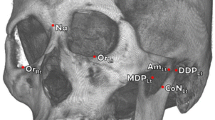Summary
Condylar hyperplasia (CH) of human temporomandibular joint (TMJ) often occurs unilaterally, and causes occlusal disturbance and facial asymmetry. The purpose of this study was to compare the effects of high condylectomy with and without postsurgical orthodontic treatment. Forty patients were diagnosed as having active CH and treated with high condylectomy. Patients in group A (n=24) took the postsurgical orthodontic therapy immediately after surgery, and those in group B (n=16) did not take orthodontic therapy. For both groups, the mandibular ramus height on the affected side was decreased significantly after surgery. Orthodontic treatment promoted maxillary alveolar remodeling significantly by depressing alveolar bone of the affected side and increasing alveolar bone of the nonaffected side. Better improvement for facial midline deviations was observed in group A than in group B. In both groups, the condylar remodeling was observed and manifested by the smoothening of condylar surface and returning of condyle to normal position in glenoid fossa. It was concluded that high condylectomy in the treatment of active CH of TMJ improved the functional occlusion and facial aesthetic. Postsurgical orthodontic therapy could more effectively enhance maxillary alveolar and condylar remodeling, and more rapidly and meticulously establish the stable occlusal and normal position of condyle than the spontaneous remodeling.
Similar content being viewed by others
References
Gray RJM, Sloan P, Quayle AA, et al. Histopathological and scintigraphic features of condylar hyperplasia. Int J Oral Maxillofac Surg, 1990,19(2):65–71
Obwegeser HL, Obwegeser JA. New clinical-based evidence for the existence of 2 growth regulators in mandibular condyles: hemimandibular elongation in hemifacial microsomia mandible. J Craniofac Surg, 2010,21(5):1595–1600
Xu M, Chan FC, ** X, et al. Hemimandibular hyperplasia: classification and treatment algorithm revisited. J Craniofac Surg, 2014,25(2):355–358
Nitzan DW, Katsnelson A, Bermanis I, et al. The clinical characteristics of condylar hyperplasia: experience with 61 patients. J Oral Maxillofac Surg, 2008,66(2):312–318
Meng Q, Chen G, Long X, et al. Histological evaluation of condylar hyperplasia model of rabbit following distraction osteogenesis of the condylar neck. J Oral Rehabil, 2011,38(1):27–33
Wolford LM, Movahed R, Perez DE. A classification system for conditions causing condylar hyperplasia. J Oral Maxillofac Surg, 2014,72(3):567–595
Wolford LM, Morales-Ryan CA, Garcia-Morales P, et al. Surgical management of mandibular condylar hyperplasia type 1. Proc (Bayl Univ Med Cent), 2009,22(4):321–329
Pereira-Santos D, De Melo WM, Souza FA, et al. High condylectomy procedure: a valuable resource for surgical management of the mandibular condylar hyperplasia. J Craniofac Surg, 2013,24(4):1451–1453
Kim YH, Han UK, Lim DD, et al. Stability of anterior openbite correction with multiloop edgewise archwire therapy: A cephalometric follow-up study. Am J Orthod Dentofacial Orthop, 2000,118(1):43–54
Deleurant Y, Zimmermann A, Peltomaki T. Hemimandibular elongation: treatment and long-term follow-up. Orthod Craniofac Res, 2008,11(3):172–179
Damstra J, Fourie Z, Ren Y. Evaluation and comparison of postero-anterior cephalograms and cone-beam computed tomography images for the detection of mandibular asymmetry. Eur J Orthod, 2013,35(1):45–50
Hodder SC, Rees JI, Oliver TB, et al. SPECT bone scintigraphy in the diagnosis and management of mandibular condylar hyperplasia. Br J Oral Maxillofac Surg, 2000,38(2):87–93
Cervelli V, Bottini DJ, Arpino A, et al. Hypercondylia: problems in diagnosis and therapeutic indications. J Craniofac Surg, 2008,19(2):406–410
Sugawara Y, Hirabayashi S, Susami T, et al. The treatment of hemimandibular hyperplasia preserving enlarged condylar head. Cleft Palate Craniofac J, 2002,39(6):646–654
Fang B, Shen GF, Yang C, et al. Changes in condylar and joint disc positions after bilateral sagittal split ramus osteotomy for correction of mandibular prognathism. Int J Oral Maxillofac Surg, 2009,38(7):726–730
Wenghoefer M, Peters A, Reich RH. Modified triaca-style wing osteotomy to correct facial asymmetry in a patient with horizontal growth-type condylar hyperplasia. J Craniofac Surg, 2013,24(5):1769–1771
Jones RH, Tier GA. Correction of facial asymmetry as a result of unilateral condylar hyperplasia. J Oral Maxillofac Surg, 2012,70(6):1413–1425
Yang WS, Kim BH, Kim YH. A study of the regional load deflection rate of multiloop edgewise arch wire. Angle Orthod, 2001,71(2):103–109
Author information
Authors and Affiliations
Corresponding authors
Rights and permissions
About this article
Cite this article
El.mozen, L.A., Meng, Qg., Li, Yj. et al. Condylar and occlusal changes after high condylectomy and orthodontic treatment for condylar hyperplasia. J. Huazhong Univ. Sci. Technol. [Med. Sci.] 35, 265–270 (2015). https://doi.org/10.1007/s11596-015-1422-5
Received:
Revised:
Published:
Issue Date:
DOI: https://doi.org/10.1007/s11596-015-1422-5




